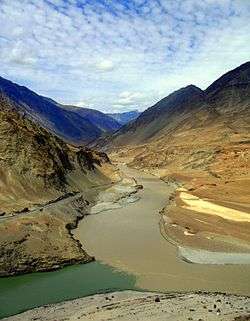Zanskar River
The Zanskar River is a north-flowing tributary of the Indus. In its upper reaches, the Zanskar has two main branches. First of these, the Doda, has its source near the Pensi-la 4,400 m (14,400 ft) mountain-pass and flows south-eastwards along the main Zanskar valley leading towards Padum, the capital of Zanskar. The second branch is formed by two main tributaries known as Kargyag river, with its source near the Shingo La 5,091 m (16,703 ft), and Tsarap river, with its source near the Baralacha-La. These two rivers unite below the village of Purne to form the Lungnak river (also known as the Lingti or Tsarap). The Lungnak river then flows north-westwards along a narrow gorge towards Zanskar's central valley (known locally as gzhung khor), where it unites with the Doda river to form the main Zanskar river. This river then takes a north-eastern course through the dramatic Zanskar Gorge until it joins the Indus near "Nimmu" in Ladakh.



| Wikimedia Commons has media related to Zanskar River. |
Tourism
Lower (northern) sections of that gorge are popular in summer with tourists making rafting trips, typically from Chiling to Nimmu. In winter when the road to Zanskar is closed by snow on the high passes, the only overland route to Padum is by walking along the frozen river, a multi-day hike that is now sold as an adventure activity called the Chadar ('ice sheet') Trek.[1] This trek will eventually be rendered obsolete once the road from Chiling to Padum is completed.[2]
References
- Sumitran, Neha (1 April 2014). "On the Mighty Chadar, Everything Freezes but Tears". National Geographic Traveller India. Retrieved 2 February 2020.
- Lonely Planet guide, Trekking in the Indian Himalaya by Garry Weare, page 71